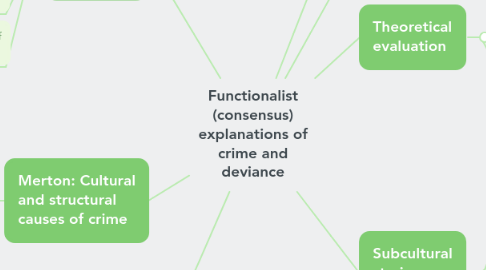
1. Durkheim: crime is inevitable
1.1. C+D functional (positive) • Generate Social Change – all change begins as deviation from social norms e.g. the authorities often persecute religious visionaries who espouse a new ‘message’ or value-system. • Creates Social Integration – bonds society together against certain crimes and criminals e.g. terrorism. • Boundary Maintainance - Helps clarify the boundaries of acceptable behaviour e.g. speeding may be tolerated but paedophilia is certainly not.
1.1.1. C+D dysfunctional (negative) •threaten value consensus, social order and social stability. •norms + values that ‘unite’ society are broken and challenged. • Too much crime + deviance can threaten value consensus, social order and social stability. •This is because the norms and values that ‘unite’ society are broken and challenged.
1.2. Theoretical evaluation: Left realists claim Durkheim neglects the victim when focusing on the positive functions of crime. Victims crime suffer both physical + psychological harm + may stay indoors for fear
2. Merton: Cultural and structural causes of crime
2.1. Individuals socialised to meet shared goals (values) - ‘American Dream’ + doing well at school
2.1.1. Disadvantaged groups e.g. working class + blacks unable to obtain goals legitimately blocked opportunities (e.g. material and cultural deprivation, failing schools, discrimination) at school and so underachieve.
2.1.1.1. some working class innovate reject approved means + turn to illegal means (crime) to obtain the goals they still desire (e.g. drug dealing, prostitution, ).
2.1.1.1.1. anomie, depending on social class background, are conformity, ritualism, retreatism and rebellion.
2.2. Merton focusses utilitarian crime commited for material gain, such as theft or fraud. + ignores: assault + vandalism - more economic motive.
2.2.1. Merton sees deviance as an individual response to strain, ignoring the fact that much deviance is committed in or by groups, especially among the young
2.2.1.1. Cohen extends Merton’s theory by incorporating a strong cultural element into his explanation:
3. A positive view of social control and social order
3.1. agencies of socialisation shared norms + values to create a value consensus + creates social order and stability. E.g. families +schools values of achievement + respect for authority. Religion instils the value of not committing adultery.
3.1.1. Sanctions - crime & deviance is controlled by negative sanctions/punishments for deviance e.g. imprisonment and positive sanctions/praise for conformity e.g. praise for working hard at school.A positive view of social control + social order
4. Introduction/key assumptions
4.1. Accept official crime statistics. + rising crime levels, working class, young black, males, in urban areas.
4.1.1. Structural causal explanation of crime & deviance – way society is organised, social background, upbringing or social position.
4.1.1.1. Assume a value consensus – agreement over norms and values (shared culture).
5. Structural causes
5.1. C+ D caused by anomie (normlessness). during periods of rapid social change
6. Theoretical evaluation
6.1. Do not account for non-utilarian crime (crime to make money) e.g. violent crimes, vandalism
6.1.1. Marxists argue that it ignores the power of the ruling class e.g. make laws that criminalise the poor but not the rich
6.1.1.1. Assumes there is ‘value consensus’ and everyone strives for ‘money success’ – ignores possibility that many may not share this goalTheoretical evaluation
6.1.1.1.1. Merton sees deviance as an individual response to anomie, and does not adequately account for the collective
7. Subcultural strain theories
7.1. Cloward & Ohlin
7.1.1. different neighbourhoods provide different illegitimate opportunities for young people to learn criminal skills and develop criminal careers.
7.1.1.1. Conflict subcultures - lack access to criminal networks but juveniles live in an area with high population turnover which values gang violence e.g. certain parts of Glasgow.
7.1.2. Criminal subcultures - have access to criminal networks. Commit material (utilitarian or money making) crimes such as burglary.
7.1.2.1. Retreatist subcultures – lack access to criminal or conflict subcultures. Typical deviancy is alcohol and drug abuse.Cultural causes of crime & deviance
7.2. Cohen
7.2.1. WC youths face blocked opportunities (e.g. obtaining poor qualifications because of material and cultural deprivation).
7.2.1.1. status frustration unable to achieve mainstream success goals legitimately.
7.2.1.1.1. Working class youths socialised into the ‘American/British Dream’.
7.3. Some WC youths reject mainstream norms + values status frustration + invert values
7.3.1. Mainstream norms + values replaced alternative delinquent subcultural norms + values. A high value is placed on negativistic (non-money making) delinquent acts. For example, joy riding, arson and vandalism.
7.3.1.1. The delinquent subculture provides an alternative means of gaining status and striking back at an unequal society.
